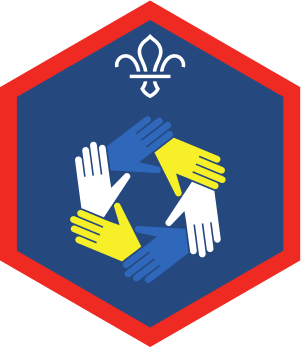In and around a circle
You’ll need
- A4 paper
- Scissors
- Pens or pencils
- Rulers
Before you begin
- You’ll need plenty of paper. Each group will need a few pieces to ‘Figure it out’, and you’ll probably need a few pieces to play ‘Circle through a loop’ too.
Figure it out
- Everyone should split into teams of four or five people.
- Each team should get a few pieces of paper, some pens or pencils, a ruler, and a pair of scissors.
- The person leading the activity should explain that it’s possible to fit the whole team through the middle of the piece of paper while the paper stays in one piece.
- Everyone should try to figure out how they can fit through the piece of paper. Once they’ve made a plan, they should experiment with all of the stationery they have.
Some people might have done this before – that’s OK. If anyone remembers how to do it, they could give everyone else a chance to figure it out by sharing the solution with their team one step at a time and leaving time for people to guess what to do next.
Share the solution
- Once a team has figured out the solution, they should share their solution with all of the others teams until they’ve all succeeded.
- If no one’s able to figure it out, the person leading the activity should share the solution.
It’s up to you whether you share it with everyone at once, or just a few people who can teach everyone else.
- Each team should make at least three loops using the solution.
Circle through a loop
- Everyone should make a circle. They should all hold hands.
- One pair should let go so the person leading the activity can put a paper loop between them. They should rejoin hands through the middle of the loop so the loop’s secured.
- Everyone should work together to pass the loop around the circle without letting go of each other’s hands (or tearing the paper loop).
If the loop tears and you need to replace it, there’s no need to start again. Just put a new loop in the circle where the last one broke.
- As they try to move the loop, everyone should problem-solve together. Is it easier for people to put their head and shoulders through first, or should they start with their feet? What does everyone else need to do to help the person who’s moving through the loop?
- Once they’ve succeeded, everyone should come together to reflect on how it went.
Reflection
This activity was all about working as a team and communicating. The task may have sounded impossible at first – how could a person squeeze through the middle of a sheet of paper? However, with a bit of knowledge and teamwork, people found a solution! Has anyone else ever discovered that they could do something that seemed impossible? How did thinking out loud with other people help everyone find the solution? Could one person have done it easily on their own?
People took it in turns to climb through the loop as it moved around the circle. Was the person climbing through the loop the only person who had to think about how they moved? It was probably easier if everyone worked together to bend or flex to help the person wiggle through. When else might people in a team need to work together to help the person in the spotlight?
Safety
All activities must be safely managed. You must complete a thorough risk assessment and take appropriate steps to reduce risk. Use the safety checklist to help you plan and risk assess your activity. Always get approval for the activity, and have suitable supervision and an InTouch process.
- Scissors
Supervise young people appropriately when they’re using scissors. Store all sharp objects securely, out of the reach of young people.
- Active games
The game area should be free of hazards. Explain the rules of the game clearly and have a clear way to communicate that the game must stop when needed. Take a look at our guidance on running active games safely.
- Different sizes of paper will make different size loops. You can also alter the size by cutting the lines closer together – this way, the bigger the loop the thinner and more fragile it’ll be.
- You could have more than one loop moving around the circle at once. You could also split into smaller circles if there are a lot of players.
- Some people could wear blindfolds, close their eyes, or face outside the circle to make it trickier.
- For a real challenge, make everyone start again if the loop tears.
- If anyone doesn’t want to hold hands, they could hold the ends of a piece of rope or scarf, and the people next to them could hold the other ends.
- If anyone isn’t able to step through the whole loop, figure out what works for them. For example, a wheelchair user may need to be allowed to break the circle quickly to get the loop around their middle then pass it on.
All Scout activities should be inclusive and accessible.
Don’t let your newly honed team skills go to waste. Could you take part in competitions, games, or bigger challenges?
